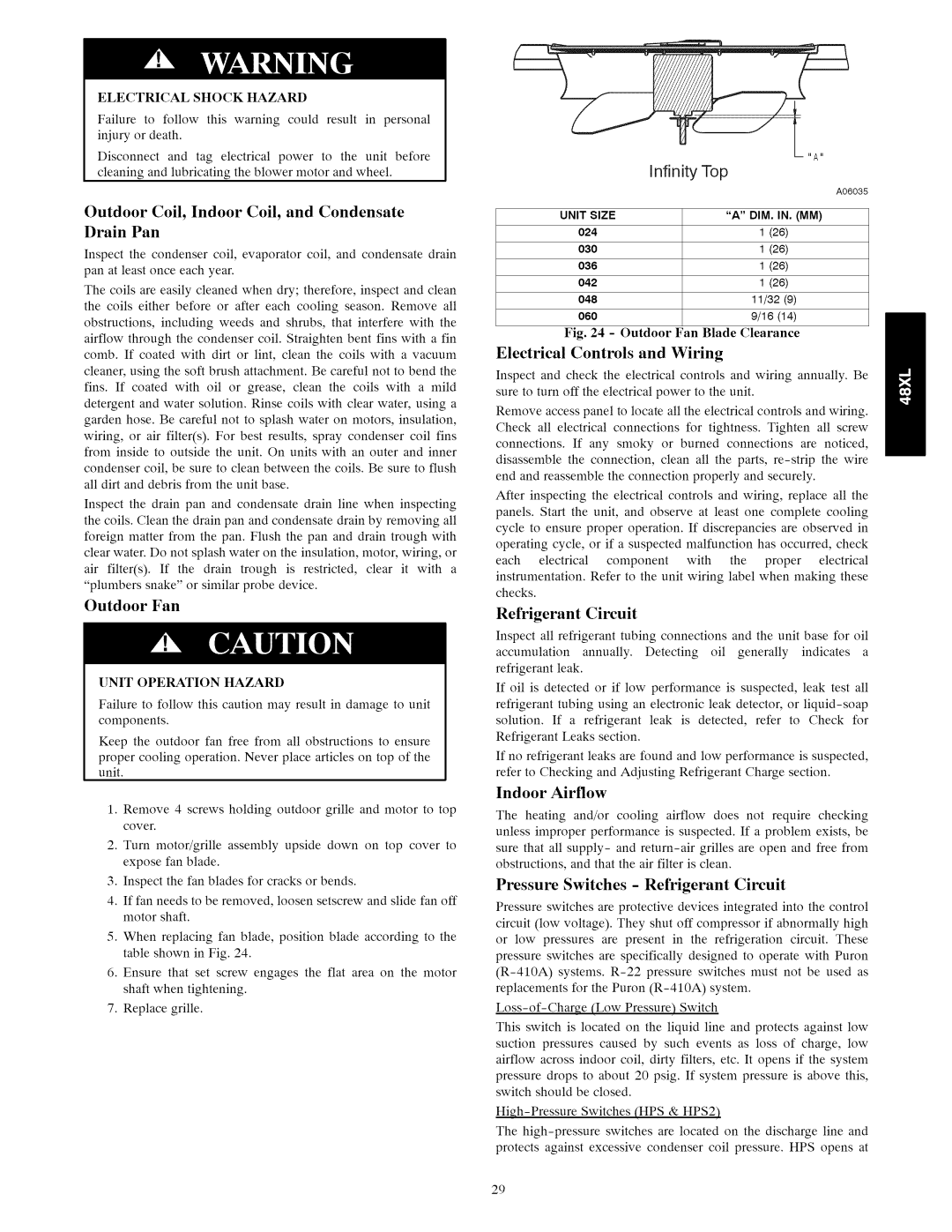
ELECTRICALSHOCKHAZARD
Failureto follow this warning could result in personal injury or death.
Disconnect and tag electrical power to the unit before cleaning and lubricating the blower motor and wheel.
Outdoor Coil, Indoor Coil, and Condensate Drain Pan
Inspect the condenser coil, evaporator coil, and condensate drain pan at least once each year.
The coils are easily cleaned when dry; therefore, inspect and clean
the coils either before or after each cooling season. Remove all
obstructions, including weeds and shrubs, that interfere with the
airflow through the condenser coil. Straighten bent fins with a fin comb. If coated with dirt or lint, clean the coils with a vacuum
cleaner, using the soft brush attachment. Be careful not to bend the fins. If coated with oil or grease, clean the coils with a mild detergent and water solution. Rinse coils with clear water, using a garden hose. Be careful not to splash water on motors, insulation,
wiring, or air filter(s). For best results, spray condenser coil fins from inside to outside the unit. On units with an outer and inner
condenser coil, be sure to clean between the coils. Be sure to flush all dirt and debris from the unit base.
Inspect the drain pan and condensate drain line when inspecting
the coils. Clean the drain pan and condensate drain by removing all foreign matter from the pan. Flush the pan and drain trough with
clear water. Do not splash water on the insulation, motor, wiring, or
air filter(s). If the drain trough is restricted, clear it with a
"plumbers snake" or similar probe device.
Outdoor Fan
UNIT OPERATION HAZARD
Failure to follow this caution may result in damage to unit components.
Keep the outdoor fan free from all obstructions to ensure
proper cooling operation, Never place articles on top of the unit,
1.Remove 4 screws holding outdoor grille and motor to top cover.
2.Turn motor/grille assembly upside down on top cover to expose fan blade.
3.Inspect the fan blades for cracks or bends.
4.If fan needs to be removed, loosen setscrew and slide fan off motor shaft.
5.When replacing fan blade, position blade according to the table shown in Fig. 24.
6.Ensure that set screw engages the flat area on the motor shaft when tightening.
7.Replace grille.
infinity | Top |
|
|
| A06035 |
UNIT SIZE | "A" DIM. IN. (MM) | |
024 | 1 | (26) |
030 | 1 | (26) |
036 | 1 | (26) |
042 | 1 | (26) |
048 | 11/32 | (9) |
060 | 9/16 | (14) |
Fig. 24 - Outdoor | Fan Blade Clearance | |
Electrical Controls and Wiring
Inspect and check the electrical controls and wiring annually. Be sure to turn off the electrical power to the unit.
Remove access panel to locate all the electrical controls and wiring.
Check all electrical connections for tightness. Tighten all screw
connections. If any smoky or burned connections are noticed,
disassemble the connection, clean all the parts,
end and reassemble the connection properly and securely.
After inspecting the electrical controls and wiring, replace all the
panels. Start the unit, and observe at least one complete cooling
cycle to ensure proper operation. If discrepancies are observed in
operating cycle, or if a suspected malfunction has occurred, check
each electrical component with the proper electrical
instrumentation. Refer to the unit wiring label when making these checks.
Refrigerant Circuit
Inspect all refrigerant tubing connections and the unit base for oil
accumulation annually. Detecting oil generally indicates a
refrigerant leak.
If oil is detected or if low performance is suspected, leak test all
refrigerant tubing using an electronic leak detector, or
solution. If a refrigerant leak is detected, refer to Check for
Refrigerant Leaks section.
If no refrigerant leaks are found and low performance is suspected,
refer to Checking and Adjusting Refrigerant Charge section.
Indoor Airflow
The heating and/or cooling airflow does not require checking
unless improper performance is suspected. If a problem exists, be
sure that all supply- and
obstructions, and that the air filter is clean.
Pressure Switches - Refrigerant Circuit
Pressure switches are protective devices integrated into the control
circuit (low voltage). They shut off compressor if abnormally high
or low pressures are present in the refrigeration circuit. These
pressure switches are specifically designed to operate with Puron
replacements for the Puron
This switch is located on the liquid line and protects against low
suction pressures caused by such events as loss of charge, low airflow across indoor coil, dirty filters, etc. It opens if the system pressure drops to about 20 psig. If system pressure is above this, switch should be closed.
The
protects against excessive condenser coil pressure. HPS opens at
29
